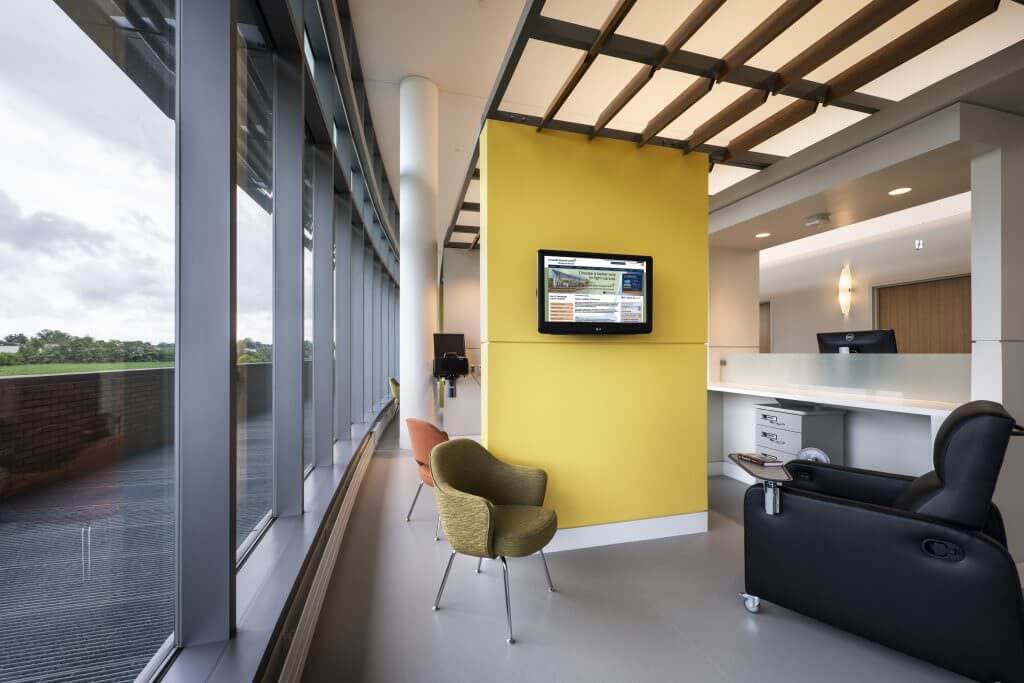Taking the Temperature of the Healthcare Industry
Flexible, efficient facilities focused on optimal patient outcomes
Tracking trends in the healthcare industry and understanding how they affect facility design is challenging. In the near term, rapidly increasing costs, structural changes in insurance reimbursements, and continuous technological advances all play major roles. The long-term effects of changing government and insurance policies, as well as the entry of potential industry disrupters (CVS’ acquisition of Aetna Health Insurance and Apple and Amazon forming their own healthcare companies) remain to be seen.
The insurance reimbursement structure is moving from a fee for service compensation to one that rewards maintaining an individual’s overall health. Healthcare providers will be working to position themselves in the evolving consumer-driven market as patient financial responsibility increases making them the primary consumer.
The expanding aging population will have a greater need for more advanced, costly medical care. This will be reserved for large hospital facilities. Satellite facilities that treat less severe cases have the advantage of lower facility operating costs and convenient patient access.
There is tremendous pressure to reduce health care costs, accommodate ever-changing technology, and improve patient outcomes. Healthcare facility owners are calling on the design and construction industry for help. Creating designs today that can cost-effectively accommodate future programming needs will be essential.
Shining a Light on Health and Wellbeing
Lighting Technology Poised to Support Healthcare Industry
Recent advances in light science and the effects of light on an individual’s health have been developing rapidly. At the same time, medical research points to the benefits of a holistic approach to patient care and the wellbeing of healthcare staff, including physical and emotional aspects.
“Forward-thinking healthcare clients have taken note, and more are requesting we incorporate these new lighting technologies into the design of their facilities,” explains Michael Barber, Associate IALD, LEED AP BD+C, Principal of The Lighting Practice. (see Project Spotlight: Saint Barnabas Medical Center)
Lighting designers have a number of products, systems, and design concepts to employ to address the challenges facing the healthcare industry. “First and foremost,” says Ryan Conover, Associate IALD, Project Manager with The Lighting Practice, “evidence-based design supports the theory that exposure to natural light clearly reduces patient stays. Incorporating it into health care facilities is a top priority.”
Replacing incandescent and fluorescent lighting with energy-efficient, LEDs will continue to take the main stage for the near future. The same goes for keeping up with the stringent department of health requirements and energy codes. Many hospitals are installing user-friendly dimming controls. They reduce maintenance costs by regulating energy use as well as provide patients and staff the ability to tailor their environment on-demand.
“By far, the newest and most exciting trend is the use of tunable white and color-changing LEDs and the associated highly configurable control systems,” explains Mike. “The healthcare industry appears to be one of the leaders in adopting the new technology.”
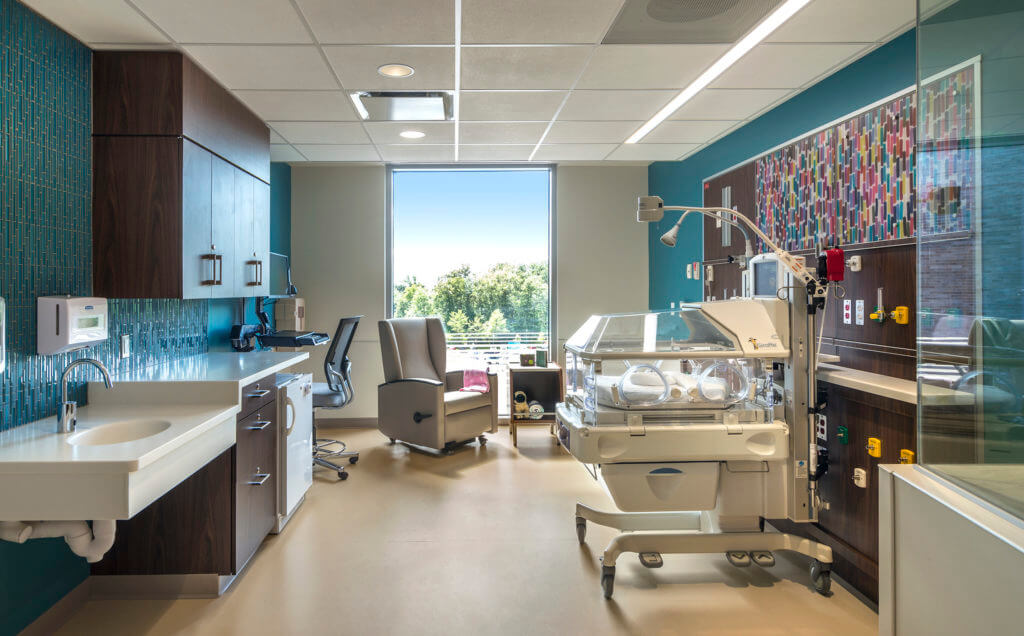
Saint Barnabas Medical Center Cooperman Family Pavilion’s light-filled patient rooms use tunable white technology. The fixtures are programmed to adjust the color temperature based on the time of day.
Smart LED lighting technology paired with daylight-responsive controls can reduce energy costs through real-time coordination with natural light levels, electrical systems, and mechanical components. “Controls can be programmed to automatically adjust light levels, window shades, heating and cooling systems throughout daily and seasonal weather fluctuations,” adds Ryan. In support of safety and comfort goals, automatic system notifications can be sent to maintenance staff as soon as a light fixture or other apparatus fails.
Responding to the rising consumer-driven market, color-changing LEDs offer unique ways to support corporate branding and wayfinding. “For example,” Mike reports, “we’ve been getting requests to add interior and exterior color-changing lighting effects.” Customizable colors and the illusion of movement can provide a soothing effect, allow for branded or health-promotion color effects, and improve patient safety and the overall experience.
Scientific studies are underway analyzing the impact of electric light on human circadian rhythms. Early reports indicate that tunable white technology may improve patient outcomes and caregiver well-being by mimicking natural light patterns that support human circadian rhythms. Deviation from an individual’s natural circadian rhythm can negatively affect sleep, appetite and mood patterns, which in turn can affect emotional and physical wellbeing as well as one’s attentiveness.
Other studies indicate that while tunable white provides visual cues to the human body that may influence sleep and wake patterns, long-term exposure to specific wavelengths of electric light may have a greater impact to human health and circadian rhythms. Lighting technology is currently being developed that will curate these wavelengths creating a balance closer to natural light. The result will be electric light that minimally impacts human health no matter the color temperature, or length of time spent basking in their glow.
“We’re following the scholarly research on how natural and electric light support staff, patients and their families,” adds Ryan. “More research needs to be done for sure, but it appears light may play a very important role in creating a healing and supportive environment. It’s very exciting to look for ways to incorporate new innovations to help meet the needs of the healthcare industry.”
Project Spotlight: Saint Barnabas Medical Center, Cooperman Family Pavilion
Livingston, NJ, USA
To support their growing patient population, RWJBarnabas Health engaged the team to design a 241,000-SF addition to the main hospital. The new Cooperman Family Pavilion includes 114 private rooms, expanded Neonatal Intensive Care Unit (NICU), centralized registration area, outpatient diagnostic services, same-day surgery suite, and a new 400-vehicle parking garage. The Lighting Practice was responsible for all exterior and interior lighting and control system design.
The design of the new facility promotes the hospital as engaging, forward-thinking and technologically advanced. The lighting design supports these initiatives and is a prominent feature throughout. Lighting supports the visual needs of visitors, patients and staff, reinforces wayfinding, and promotes energy saving goals. Natural daylight and dimmable electric light are strategically used to promote well-being and connectivity to the outside world.
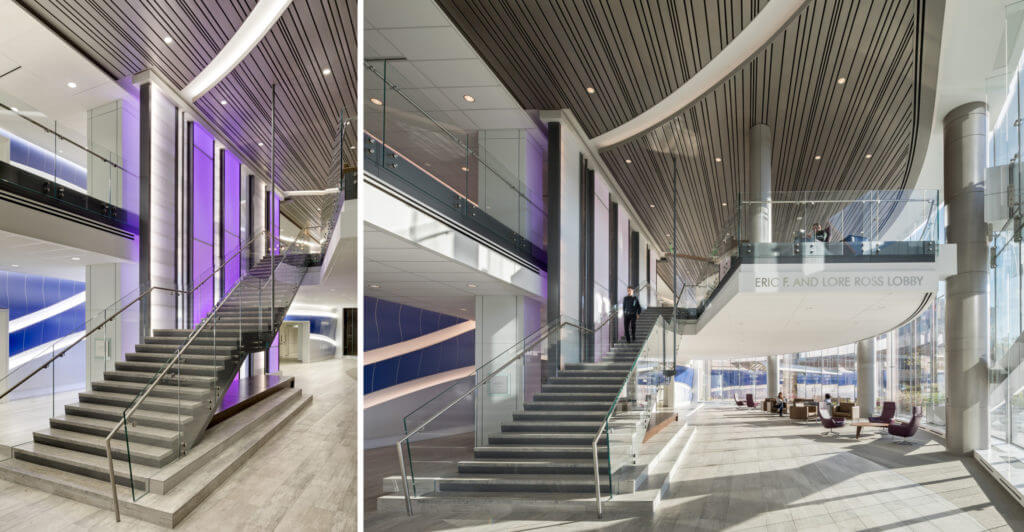
Upon arrival, visitors are greeted by a dynamic LED feature wall. The 3500K DMX512-controlled grazers create a cascading waterfall effect. Color-changing LED panels transform the wall during holidays and health awareness months. Undulating, wave-like forms flow through major public corridors and gathering spaces. These references to water provide a soothing visual break from procedural norms. The placement of these design features also supports wayfinding by creating a sense of arrival at major destinations and providing familiar cues when navigating corridors.
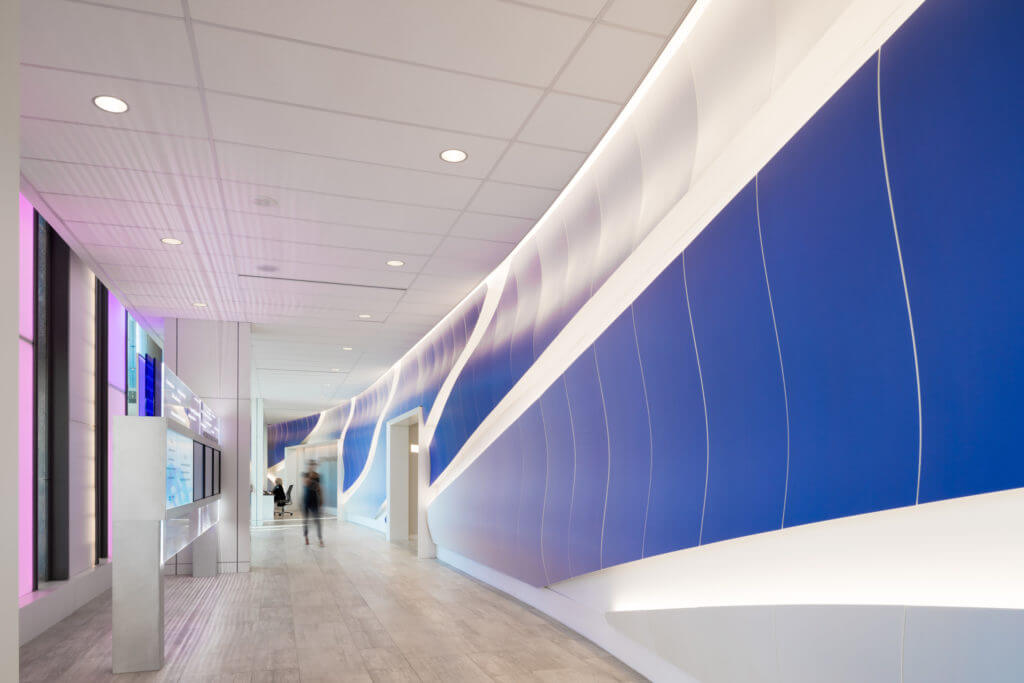
A tunable white (LED) lighting system, implemented in the NICU, is programmed to adjust color from 2700K to 6500K. This electric lighting system supplements natural daylight with the goal of regulating newborns’ circadian rhythm. Tunable white lighting fixtures are programmed to adjust color temperature, ranging from a warm amber to a cool blue, based on the time of day.
To support their community and publicly participate in health awareness months, the hospital embraced programmable color-changing LEDs to illuminate the exterior frame of the pavilion. The result is a welcoming hospital addition that sets the bar for innovative healthcare.
Lighting Lessons
Mock-ups were an important part of the Saint Barnabas Medical Center Cooper Pavilion design process. Full-scale mock-ups of procedural and patient rooms were built on-site where staff could experience spatial layouts and lighting treatments. Comments collected during the mock-ups enabled design revisions to be incorporated into the final documentation. In addition, Situ Fabrication coordinated mock-ups of the lobby feature and wave walls, prior to actual construction. Specifically, the wave-like lobby walls were constructed to ensure dimmable 3500K LED tape light, was hidden yet effective. The mock-ups ensured the conceptual ideas TLP generated with the design team would be successfully implemented and meet the owner and design team’s expectations.
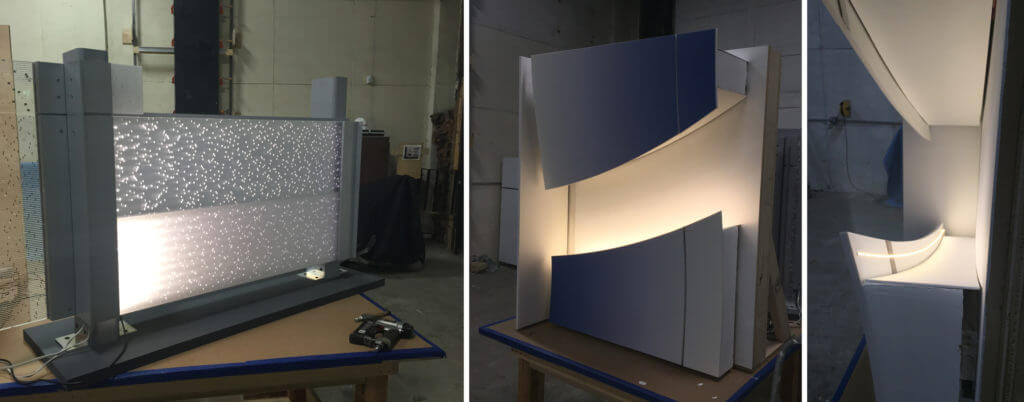
Credits
Owner: RWJBarnabas Health
Architect: FCA; Contractor: W.M. Blanchard Co.; Structural Engineer: The Harman Group; Site/Civil Engineer: Dewberry; MEP/FP Engineer: PWI Engineering; Lighting Design: The Lighting Practice
Photography respectively by Chris Cooper and Bjӧrg Magnea
